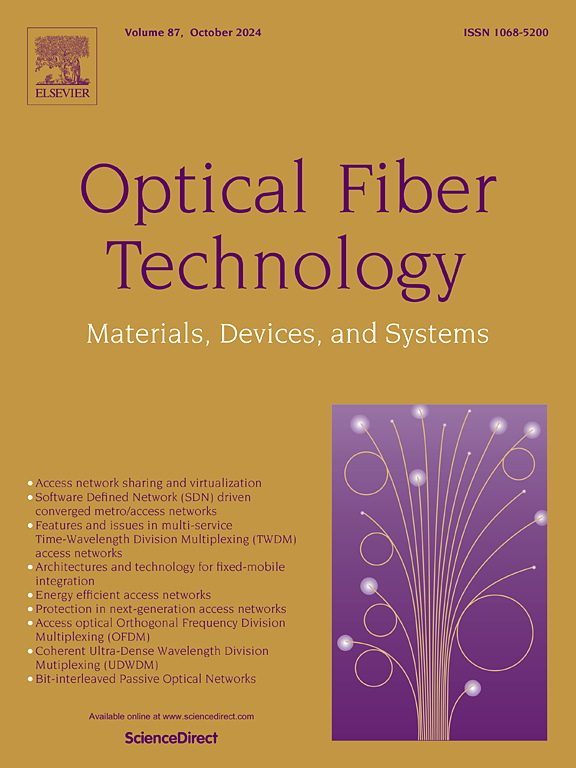Supercontinuum generation in bromotrichloromethane-filled core photonic crystal fibers
IF 2.6
3区 计算机科学
Q2 ENGINEERING, ELECTRICAL & ELECTRONIC
引用次数: 0
Abstract
Liquids have the advantages of a wide transparency window and high nonlinearity, which makes them a good medium for super-continuum (SC) generation. In this work, we designed and numerically investigated for the first time two photonic crystal fiber (PCF) structures with CBrCl3 as the core and fused silica as the cladding material for broadband SC generation. The propagation of the ultrashort pulse in the proposed fibers is modeled using the generalized nonlinear Schrodinger equation (GNLSE). The first fiber #F1 with a lattice constant (Λ) of 1.5 μm and filling factor (f) of 0.35, operates with a completely normal dispersion region. By pumping a pulse source with a wavelength of 1.56 μm, an input energy of 2.5 nJ, and a pulse duration of 90 fs in a 10 cm long fiber, an ultra-broadband, and highly coherent SC spectrum is produced, covering the wavelength range from 885.3 nm to 1953.8 nm (bandwidth of 1068.5 nm) with less than 10 dB spectral dynamic range. The second proposed fiber #F2 with a lattice constant of 2.0 μm and a filling factor of 0.3, exhibits an anomalous dispersion for wavelengths longer than 1350 nm. We obtained high coherence of the SC pulses in the range of anomalous dispersion over wavelengths from 912.2 nm to 3714.8 nm (bandwidth of 2802.6 nm) within a level of 45 dB. The pump pulse here has the same wavelength as the first fiber case, but its input energy is only 1.0 nJ. Our proposed fibers open up new avenues for the development of high-brightness SC sources from the near- to mid-IR regions.
求助全文
约1分钟内获得全文
求助全文
来源期刊

Optical Fiber Technology
工程技术-电信学
CiteScore
4.80
自引率
11.10%
发文量
327
审稿时长
63 days
期刊介绍:
Innovations in optical fiber technology are revolutionizing world communications. Newly developed fiber amplifiers allow for direct transmission of high-speed signals over transcontinental distances without the need for electronic regeneration. Optical fibers find new applications in data processing. The impact of fiber materials, devices, and systems on communications in the coming decades will create an abundance of primary literature and the need for up-to-date reviews.
Optical Fiber Technology: Materials, Devices, and Systems is a new cutting-edge journal designed to fill a need in this rapidly evolving field for speedy publication of regular length papers. Both theoretical and experimental papers on fiber materials, devices, and system performance evaluation and measurements are eligible, with emphasis on practical applications.
 求助内容:
求助内容: 应助结果提醒方式:
应助结果提醒方式:


